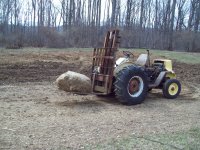My dad is worried that we will hit a rock with the 3-pt one and ruin something, and thinks we should get a pull behind one that has springs and a reset of some sort. Any opinions? The 3-point would be great to have, but will I bust something without a spring/reset?
Does your tractor have Position Control and Draft Control? Usually these are two levers, side-by-side, which control lifting the Three Point Hitch.
Draft Control is part of the original Harry Ferguson design of the Three Point Hitch developed in the 1920's, when plowing was a tractor's most important job. Draft Control's specific function is to automatically lift the plow if an obstruction is encountered underground.
Older Three Point Hitch mounted plows had either shear bolt protection or spring trip protection. With either plow protection, plus Draft Control, you should be good to go plowing food plots, although plowing on slopes is an
advanced skill. On slopes, ideally, you would use a plow with Landing Lever adjustment too.
I think new plows sold today have shear bolt protection if they have any plow protection at all.
If you do not use a Three Point mounted plow you will loose a lot of your tractor's traction. The whole point of Harry Ferguson's Three Point Hitch is to make the tractor and implement one unit, transferring implement weight to the rear wheels to improve traction. Ferguson's Three Point Hitch is what created the modern, relatively light weight, tractor. (Pre-Ferguson tractors were six tons and up.)
Draft Control is often an option on new compact tractors today, because few owners plow and most want less control complication, rather than more. Draft Control remains standard equipment on Big Ag tractors.
If you shop for a plow, look for a 2-12", with which you can plow 5-7" deep. You do not need a 2-14" which will leave the land rougher.
To educate everyone here, what is the disc diameter on the Disc Harrow you have tried? Disc Harrows are considered secondary tillage implements but they
usually work fine for scratching in food plots if heavy enough and if the ground is moist. For your tractor I would think you would need a Disc Harrow with 20" diameter discs over loam, minimum, better 22" diameter. If you have any rocks, 22" diameter discs minimum.
I have a Ford Series 101, 2-12 trip plow, with a Landing Lever. I have $500 optional Draft Control on my
L3560. While I only plow around twenty hours per year, plowing is interesting "sport" and teaching myself optimal plow adjustment is what I call fun.


